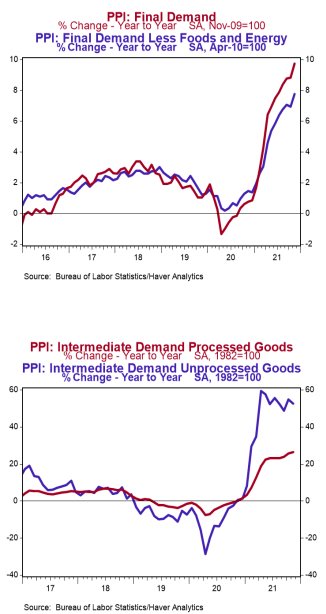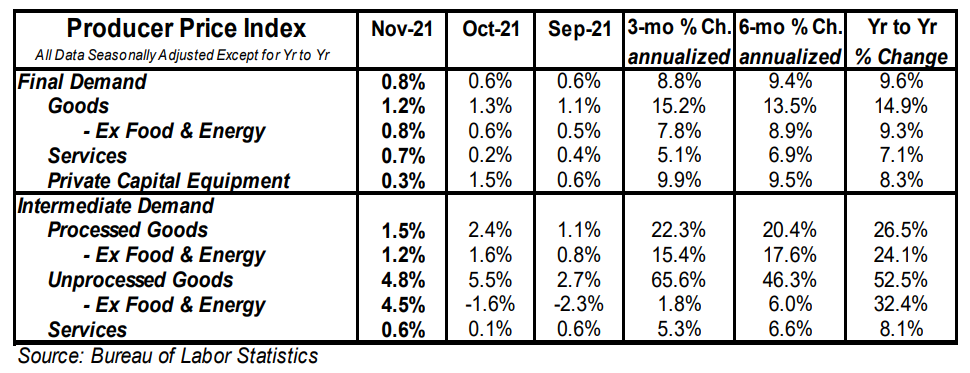- The Producer Price Index (PPI) rose 0.8% in November, well above the consensus expected +0.5%. Producer prices are up 9.6% versus a year ago.
- Energy prices rose 2.6% in November, while food prices increased 1.2%. Producer prices excluding food and energy increased 0.7% in November and are up 7.7% in the past year.
- In the past year, prices for goods are up 14.9%, while prices for services have risen 7.1%. Private capital equipment prices increased 0.3% in November and are up 8.3% in the past year.
- Prices for intermediate processed goods rose 1.5% in November and are up 26.5% versus a year ago. Prices for intermediate unprocessed goods rose 4.8% in November and are up 52.5% versus a year ago.
Implications:
Producer prices continue to rise at the fastest pace in decades, up 0.8% in November and 9.6% in the past year, with little sign inflation pressures are going to ease. As the Fed begins meeting today, the data on consumer prices (released last Friday) and producer prices should all but cement an acceleration in the tapering of asset purchases in preparation for possible rate hikes in 2022. The Fed has finally acknowledged that inflation is not “transitory” as it said time and time again during the last eighteen months. The December 2020 forecast from the Fed for inflation in 2021 to come in at 1.8% shows its models fundamentally misunderstand the drivers of sustained inflation. Yes, supply-chain issues continue to exert upward pressure on prices. From the shortage in semiconductors to difficulties finding labor, supply simply hasn’t kept up with demand. And while the port congestion gets the news coverage, each step in the distribution process – from drivers to move loads out of the ports, trains available to move them across the country, and staff available to unload at warehouses – faces difficulties trying to meet demand. But supply-chain issues will ultimately prove temporary. What is not temporary is the huge increase in the M2 money supply – now 39% above pre-COVID levels – which will drive inflation over the longer term. In terms of the details for November, prices for both goods and services ran well above the historical pace, up 1.2% and 0.7%, respectively, in November. Energy prices continue to surge, rising 2.6% in November and up 43.6% in the past year, while food prices are up double-digits over the past twelve months, as well. But even stripping out the typically volatile food and energy components shows “core” prices rose 0.7% in November and are up 7.7% in the past year. It simply doesn’t matter how you cut it or which inflation gauge you prefer, they all show that Washington’s response to COVID has put the Fed behind the curve.





